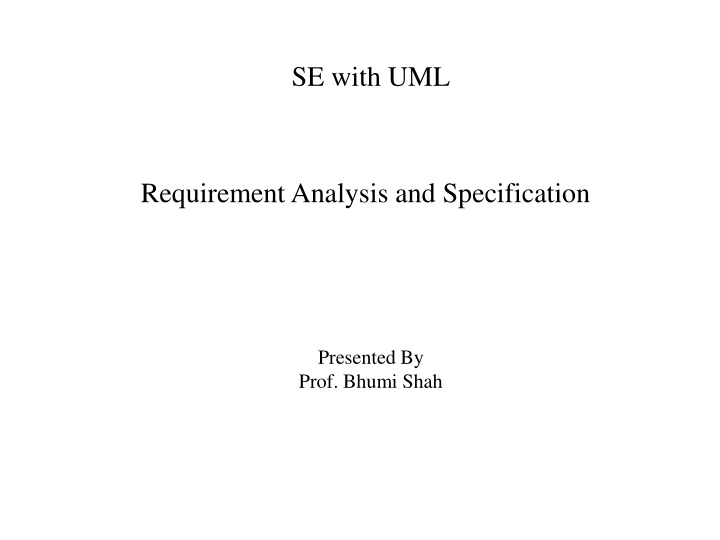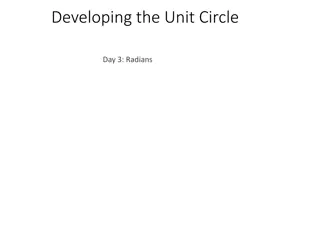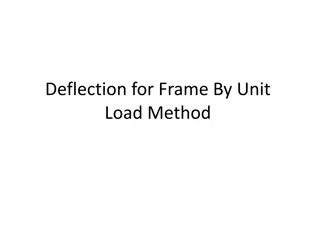
Exploring Requirements Engineering in Software Development
Discover the significance of Requirements Engineering (RE) in software development, including its fundamental principles, characteristics of good requirements, types of requirements, challenges in obtaining good requirements, and key tasks involved in the RE process. Dive deep into the complexities and importance of understanding and defining requirements effectively to ensure successful system outcomes.
Download Presentation

Please find below an Image/Link to download the presentation.
The content on the website is provided AS IS for your information and personal use only. It may not be sold, licensed, or shared on other websites without obtaining consent from the author. If you encounter any issues during the download, it is possible that the publisher has removed the file from their server.
You are allowed to download the files provided on this website for personal or commercial use, subject to the condition that they are used lawfully. All files are the property of their respective owners.
The content on the website is provided AS IS for your information and personal use only. It may not be sold, licensed, or shared on other websites without obtaining consent from the author.
E N D
Presentation Transcript
SE with UML Requirement Analysis and Specification Presented By Prof. Bhumi Shah
Requirements Engineering Requirement: A function, constraint or other property that the system must provide to fill the needs of the system s intended user(s) Engineering: implies that systematic and repeatable techniques should be used Requirement Engineering means that requirements for a product are defined, managed and tested systematically
Requirements Engineering It is essential that the software engineering team understand the requirements of a problem before the team tries to solve the problem. In some cases requirements engineering may be abbreviated, but it is never abandoned. RE is software engineering actions that start with communication activity and continues into the modeling activity. RE establishes a solid base for design and construction. Without it, resulting software has a high probability of not meeting customer needs.
Characteristics of a Good Requirement Clear and Unambiguous standard structure has only one possible interpretation Not more than one requirement in one sentence Correct A requirement contributes to a real need Understandable A reader can easily understand the meaning of the requirement Verifiable A requirement can be tested Complete Consistent Traceable
Types of requirement: 1. Normal Requirements reflect objectives and goals stated for product. If requirement are present in final products, customer is satisfied. 1. Expected Requirements customer does not explicitly state them. Customer assumes it is implicitly available with the system. 1. Exciting Requirements- Features that go beyond the customer s expectation.
Why is Getting Good Requirements Hard? Stakeholders don t know what they really want. Stakeholders express requirements in their own terms. Different stakeholders may have conflicting requirements. Organisational and political factors may influence the system requirements. The requirements change during the RE process. New stakeholders may emerge and the business environment change.
Requirement Engineering Tasks Inception Elicitation Elaboration Negotiation Specification Validation Requirements Management
Requirements Engineering Tasks Inception Establish a basic understanding of the problem and the nature of the solution. Elicitation Draw out the requirements from stakeholders. Elaboration (Highly structured) Create an analysis model that represents information, functional, and behavioral aspects of the requirements. Negotiation Agree on a deliverable system that is realistic for developers and customers. Specification Describe the requirements formally or informally. Validation Review the requirement specification for errors, ambiguities, omissions, and conflicts. Requirements management Manage changing requirements.
Inception Inception Ask context-free questions that establish Basic understanding of the problem The people who want a solution The nature of the solution that is desired, and The effectiveness of preliminary communication and collaboration between the customer and the developer
Elicitation Elicitation - elicit requirements from customers, users and others. Find out from customers, users and others what the product objectives are what is to be done how the product fits into business needs, and how the product is used on a day to day basis
Requirement elicitation : difficult? Problems of scope: The boundary of the system is ill-defined. Customers/users specify unnecessary technical detail that may confuse rather than clarify objectives. Problem of understanding: Customers are not completely sure of what is needed. Customers have a poor understanding of the capabilities and limitations of the computing environment. Customers don t have a full understanding of their problem domain. Customers have trouble communicating needs to the system engineer. Customers omit detail that is believed to be obvious. Customers specify requirements that conflict with other requirements. Customers specify requirements that are ambiguous or not able to test. Problems of volatility: Requirement change over time.
Elaboration Focuses on developing a refined technical model of software functions, features, and constraints using the information obtained during inception and elicitation Create an analysis model that identifies data, function and behavioral requirements. It is driven by the creation and refinement of user scenarios that describe how the end-user will interact with the system. End result defines informational, functional and behavioral domain of the problem
Elaboration Task During elaboration, the software engineer takes the information obtained during inception and elicitation and begins to expand and refine it Elaboration focuses on developing a refined technical model of software functions, features, and constraints It is an analysis modeling task Use cases are developed Domain classes are identified along with their attributes and relationships State machine diagrams are used to capture the life on an object The end result is an analysis model that defines the functional, informational, and behavioral domains of the problem
Developing Use Cases Step One Define the set of actors that will be involved in the story Actors are people, devices, or other systems that use the system or product within the context of the function and behavior that is to be described Actors are anything that communicate with the system or product and that are external to the system itself Step Two Develop use cases, where each one answers a set of questions
Negotiation Negotiation - agree on a deliverable system that is realistic for developers and customers Requirements are categorized and organized into subsets Relations among requirements identified Requirements reviewed for correctness Requirements prioritized based on customer needs Negotiation about requirements, project cost and project timeline.
Specification Specification Different things to different people. It can be Written Document A set of graphical models, A formal mathematical models Collection of usage scenario. A prototype Combination of above. The Formality and format of a specification varies with the size and the complexity of the software to be built. For large systems, written document, language descriptions, and graphical models may be the best approach. For small systems or products, usage scenarios
Validation Requirements Validation - formal technical review mechanism that looks for Errors in content or interpretation Areas where clarification may be required Missing information Inconsistencies (a major problem when large products or systems are engineered) Conflicting or unrealistic (unachievable) requirements.
Requirement Management Set of activities that help project team to identify, control, and track requirements and changes as project proceeds Requirements begin with identification. Each requirement is assigned a unique identifier. Once requirement have been identified, traceability table are developed. Traceability Table: Features traceability table - shows how requirements relate to customer observable features Source traceability table - identifies source of each requirement Dependency traceability table - indicate relations among requirements Subsystem traceability table - requirements categorized by subsystem Interface traceability table - shows requirement relations to internal and external interfaces It will help to track, if change in one requirement will affect different aspects of the system.
Initiating Requirements Engineering Process Identify stakeholders Stakeholder can be anyone who benefits in a direct or indirect way from the system which is being developed Ex. Business manager, project manager, marketing people, software engineer, support engineer, end-users, internal- external customers, consultants, maintenance engineer. Each one of them has different view of the system.
Initiating Requirements Engineering Process Recognize multiple points of view Marketing group concern about feature and function to excite potential market. To sell easily in the market. Business manager concern about feature built within budget and will be ready to meet market. End user Easy to learn and use. SE product functioning at various infrastructure support. Support engineer Maintainability of software. Role of RE is to categorize all stakeholder information in a way that there could be no inconsistent or conflict requirement with one another
Work toward collaboration RE identify areas of commonality (i.e. Agreed requirement) and areas of conflict or inconsistency. It does not mean requirement defined by committee. It may happened they providing just view of their requirement. Business manager or senior technologist may make final decision. Asking the first questions Who is behind the request for this work? Who will use the solution? What will be the economic benefit of a successful solution Is there another source for the solution that you need? These questions will help stakeholder interest in the software & measurable benefit of successful implementation.
Asking the question Next set of questions better understanding of the problem. What business problem (s) will this solution address? Describe business environment in which the solution will be used? will performance or productivity issues affect the solution is approached? Final set of questions Effectiveness of communication Are my questions relevant to the problem? Am I asking too many questions? Can anyone else provide additional information? should I be asking you anything else?
Eliciting Requirement Approach for eliciting requirement: Collaborative Requirement Gathering Quality Function Deployment User Scenarios Elicitation Work Products
Collaborative Requirement Gathering Meetings are attended by all interested stakeholders. Rules established for preparation and participation. Agenda should be formal enough to cover all important points, but informal enough to encourage the free flow of ideas. A facilitator controls the meeting. A definition mechanism (blackboard, flip charts, etc.) is used. During the meeting: The problem is identified. Elements of the solution are proposed. Different approaches are negotiated. A preliminary set of solution requirements are obtained. The atmosphere is collaborative and non-threatening. Flow of event Outline the sequence of events occurs Requirement gathering meeting ( initial meeting) During meeting Follow the meeting.
Collaborative requirement gathering (contd.) In initial meeting, distribute Product request (defined by stakeholder) to all attendee. Based on product request, each attendee is asked to make List of objects (Internal or external system objects) List of services( Processes or functions) List of constraints ( cost, size, business rules) and performance criteria( speed, accuracy) are developed. Collect lists from everyone and combined. Combined list eliminates redundant entries, add new ideas , but does not delete anything. Objective is to develop a consensus list in each topic area (objects, services, constraints and performance). Based on lists, team is divided into smaller sub-teams : each works to develop mini-specification for one or more entries on each of the lists.
Collaborative requirement gathering (Contd.) Each sub-team the presents its mini-specification to all attendees for discussion. Addition, deletion and further elaboration are made. Now each team makes a list of validation criteria for the product and present to team. Finally, one or more participants is assigned the task of writing a complete draft specification.
Quality Function Deployment It is a technique that translate the needs of the customer into technical requirement for software. Concentrates on maximizing customer satisfaction. QFD emphasizes what is valuable to the customer and then deploys these values throughout the engineering process. Three types of requirement: 1. Normal Requirements reflect objectives and goals stated for product. If requirement are present in final products, customer is satisfied. 2. Expected Requirements customer does not explicitly state them. Customer assumes it is implicitly available with the system. 3. Exciting Requirements- Features that go beyond the customer s expectation.
Quality Function Deployment During meeting with customer Function deployment determines the value of each function required of the system. Information deployment identifies data objects and events and also tied with functions. Task deployment examines the behavior of the system. Value analysis determines the priority of requirements during these 3 deployments
User Scenario It is difficult to move into more software engineering activities until s/w team understands how these functions and features will be used by diff. end-users. Developers and users create a set of usage threads for the system to be constructed A use-case scenario is a story about how someone or something external to the software (known as an actor) interacts with the system. Describe how the system will be used Each scenario is described from the point-of-view of an actor a person or device that interacts with the software in some way
Elicitation Work Products Elicitation work product will vary depending upon the size of the system or product to be built. Statement of need and feasibility. Statement of scope. List of participants in requirements elicitation. Description of the system s technical environment. List of requirements and associated domain constraints. List of usage scenarios. Any prototypes developed to refine requirements.
Questions Commonly Answered by a Use Case Who is the primary actor(s), the secondary actor(s)? What are the actor s goals? What preconditions should exist before the scenario begins? What main tasks or functions are performed by the actor? What exceptions might be considered as the scenario is described? What variations in the actor s interaction are possible? What system information will the actor acquire, produce, or change? Will the actor have to inform the system about changes in the external environment? What information does the actor desire from the system? Does the actor wish to be informed about unexpected changes?
Specification Mode of specification has much to do with the quality of solution. If specification incomplete, inconsistent, or misleading specifications have experienced the frustration and confusion that invariably results. Specification Principles: May be viewed as representation process. 1. Separate functionality from implementation. 2. Develop a model of the desired behavior of a system. 3. Establish the context in which software operates by specifying the manner. 4. Define the environment in which the system operates and indicate how.
Specification Principles (cont.) 5. Create a cognitive model rather than a design or implementation model. The cognitive model describes a system as perceived by its user community. The specifications must be tolerant of incompleteness and augmentable. Establish the content and structure of a specification in a way that will enable it to be amenable to change. 6. 7.
Specification Representation Representation format and content should be relevant to the problem. For example, a specification for a manufacturing automation system might use different symbology, diagrams and language than the specification for a programming language compiler. Information contained within the specification should be nested (layered). Paragraph and diagram numbering schemes should indicate the level of detail that is being presented. It is sometimes worthwhile to present the same information at different levels of abstraction to aid in understanding. Diagrams and other notational forms should be restricted in number and consistent in use. Confusing or inconsistent notation, whether graphical or symbolic, degrades understanding and fosters errors. Representations should be revisable.
Organization of SRS Document 1. Introduction (a) Background (b) Overall Description (c) Environmental Characteristics Hardware Peripherals People 2. Goals of Implementation 3. Functional Requirement 4. Nonfunctional Requirements 5. Behavioral Description(Optional) (a) System states (b) Events and actions
Properties of good SRS Concise: The SRS document should be concise and at the same time unambiguous, consistent, and complete. Verbose and irrelevant descriptions reduce readability and also increase error possibilities. Structured: It should be well-structured. A well-structured document is easy to understand and modify. In practice, the SRS document undergoes several revisions to requirements. Often, the customer requirements evo lve over a period of time. Therefore, in order to make the modifications to the SRS document easy, it is important to make the document well- structured. cope up with the customer
Properties of good SRS Black-box view: It should only specify what the system should do and refrain from stating how to do these. This means that the SRS document should specify the external behavior of the system and not discuss the implementation issues. The SRS document should view the system to be developed as black box, and should specify the externally visible behavior of the system. For this reason, the SRS document is also called the black-box specification of a system. Conceptual integrity: It should show conceptual integrity so that the reader can easily understand it. Response to undesired events: It should characterize acceptable responses to undesired events. These are called system response to exceptional conditions.
Software Requirements Specification It contains a complete information description, a detailed functional description, a representation of system behavior, an indication of performance requirements and design constraints, appropriate validation criteria, and other information pertinent to requirements. Format of SRS: Introduction of the software requirements specification states the goals and objectives of the software, describing it in the context of the computer-based system. Information content, flow, and structure are documented. Hardware, software, and human interfaces are described for external system elements and internal software functions. Functional Description A processing narrative is provided for each function, design constraints are stated and justified & performance characteristics are stated Behavioral Description operation of the software as a consequence of external events and internally generated control characteristics.
Software Requirements Specification (Cont.) Validation Criteria is probably the most important and, ironically, the most often neglected section of the Software Requirements Specification (SRS). Testing or validating each user-scenario. Finally, the specification includes a Bibliography and Appendix. The bibliography contains references to all documents that relate to the software. The appendix contains information that supplements the specifications
Specification Review A review of the SRS (and/or prototype) is conducted by both the software developer and the customer. Conducted at a macroscopic level Ensure that specification is complete Consistent Accurate (Information, functional and behavioral domain considered). Review becomes more detailed while examining Information, functional and behavioral domain.
Review (cont.) Once review is complete SRS signed off by both customer and developer. ( contract for software development) Requests for changes in requirements after the specification is finalized will not be eliminated. Change is an extension of software scope and therefore can increase cost and/or delivery of product. During the review, changes to the specification may be recommended. It can be extremely difficult to assess the global impact of a change; that is, how a change in one function affects requirements for other functions
Purpose of Design Design is where customer requirements, business needs, and technical considerations all come together in the formulation of a product or system The design model provides detail about the software data structures, architecture, interfaces, and components The design model can be assessed for quality and be improved before code is generated and tests are conducted Does the design contain errors, inconsistencies, or omissions? Are there better design alternatives? Can the design be implemented within the constraints, schedule, and cost that have been established?
Purpose of Design (continued) A designer must practice diversification and convergence The designer selects from design components, component solutions, and knowledge available through catalogs, textbooks, and experience The designer then chooses the elements from this collection that meet the requirements defined by requirements engineering and analysis modeling Convergence occurs as alternatives are considered and rejected until one particular configuration of components is chosen Software design is an iterative process through which requirements are translated into a blueprint for constructing the software Design begins at a high level of abstraction that can be directly traced back to the data, functional, and behavioral requirements As design iteration occurs, subsequent refinement leads to design representations at much lower levels of abstraction 46
Software Quality Guidelines and Attributes Three characteristics that serve as a guide for the evaluation of a good design: 1. The design must implement all of the explicit requirements contained in the requirements model, and it must accommodate all of the implicit requirements desired by stakeholders. 1. The design must be a readable, understandable guide for those who generate code and for those who test and subsequently support the software. 1. The design should provide a complete picture of the software, addressing the data, functional, and behavioral domains from an implementation perspective
Quality Guidelines 1. A design should exhibit an architecture that (1) has been created using recognizable architectural styles or patterns, (2) is composed of components that exhibit good design characteristics and (3) can be implemented in an evolutionary fashion,2 thereby facilitating implementation and testing. 2. A design should be modular; that is, the software should be logically partitioned into elements or subsystems. 3. A design should contain distinct representations of data, architecture, interfaces, and components. 4. A design should lead to data structures that are appropriate for the classes to be implemented and are drawn from recognizable data patterns.
Quality Guidelines 5. A design should lead to components that exhibit independent functional characteristics. 5. A design should lead to interfaces that reduce the complexity of connections between components and with the external environment. 5. A design should be derived using a repeatable method that is driven by information obtained during software requirements analysis. 5. A design should be represented using a notation that effectively communicates its meaning
Quality Attributes Hewlett-Packard developed a set of software quality attributes that has been given the acronym FURPS functionality:assessed by evaluating the feature set and capabilities of the program usability:assessed by considering human factors, overall aesthetics, consistency, and documentation reliability:evaluated by measuring the frequency and severity of failure, the accuracy of output results, the mean-time-to-failure (MTTF), the ability to recover from failure, and the predictability of the program






















